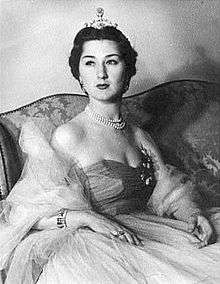Fatma Neslişah
| ||||||||||||||||||||||
Princess Fatma Neslişah Sultan (Osmanoğlu), Princess Imperial of the Ottoman Empire and Princess of Egypt, (or fully, Devletlu İsmetlu Fatma Neslişah Sultan Aliyyetü'ş-Şân Hazretleri) (4 February 1921, in Istanbul, Nişantaşı, Nişantaşı Palace – Istanbul, 2 April 2012), was a paternal granddaughter of the last Ottoman Caliph Abdülmecid II by his first wife, Şehsuvar Kadınefendi[a] and maternal granddaughter of the last Ottoman Sultan and Caliph Mehmed VI Vahidettin by first wife, Emine Nazikedâ Kadınefendi. She was the daughter of Prince Şehzade Omer Faruk Efendi (Istanbul, Ortaköy, Ortaköy Palace, 27/29 February 1898 – 28 March 1969/1971) and first wife and cousin (m. Yıldız Palace, 29 April 1920) Princess Rukiye Sabiha Sultan (Istanbul, Ortaköy, Ortaköy Palace, 19 March/1 April 1894 - Istanbul, 26 August 1971).
She grew up in Nice, France after being exiled since she was 3 years old, when the Imperial House of Osman left Istanbul in accordance with Republican regulations and laws.
Life in Egypt
In 1940 Her Imperial Highness Fatma Neslişah married Prince Muhammad Abdel Moneim, son of Egypt's last khedive Abbas Hilmi II. She thus also became Princess consort of Egypt.[1][2] Two years earlier, Abdel Moneim, heir to a US$50,000,000 fortune, had obtained permission from his second cousin King Farouk of Egypt to marry Princess Myzejen (1909–1969), sister of King Zog I of Albania.[3] However, the marriage never took place and Prince Abdel Moneim married Neslişah instead. When the Egyptian Free Officers Movement deposed King Farouk in the July 1952 Revolution, they chose Prince Abdel Moneim to serve as chairman of the three-member Regency Body established to assume the powers of Farouk's newly enthroned infant son Fuad II. The Regency Body was dissolved on 7 September 1952, and Abdel Moneim was appointed as sole Prince regent.[4] In the absence of a Queen consort, Neslişah de facto served as such by virtue of her position as the wife of the Prince regent. Her few official appearances during her husband's regency focused on charity work. Like the royal consorts who preceded her, she attended sporting events such as polo matches and the international tennis tournament final.[5]
Prince Abdel Moneim's regency lasted ten months in all. The Egyptian Revolutionary Command Council formally abolished the monarchy on 18 June 1953. In 1957, Abdel Moneim and Neslişah were arrested and accused of taking part in a plot against President Gamal Abdel Nasser.[6] Again forced into exile, Neslişah was released from prison after the President of the Republic of Turkey intervened and demanded her release. She subsequently lived for a short time in Europe, then returned to her native Turkey.[7] Prince Abdel Moneim died in 1979 in Istanbul, where Princess Neslişah continued to live with her unmarried daughter Iqbal.[5] At the time of her death, Neslişah was the most senior Ottoman princess.[8] After the deaths of Prince Burhaneddin Cem in 2008 and Prince Ertuğrul Osman in 2009, she was also the last surviving member of the Ottoman Dynasty to have been born during the Ottoman era.
Children and Family
Neslişah and Abdel Moneim had two children, one son and one daughter:
- Prince Abbas Hilmi (born Cairo, October 16, 1941), married in Istanbul on June 1, 1969 to Mediha Momtaz (born Cairo, May 12, 1945), and had one daughter and one son:
- Princess HGlory Nabila Sabiha Fatima Hilmi Hanım (born London, September 28, 1974).
- Prince HGlory Nabil Daoud Abdelmoneim Hilmi Bey (born Paddington, London, July 23, 1979).
- Princess İkbal Hilmi Abdulmunim Hanımsultan (born December 22, 1944), unmarried and without issue.
See also
Notes
- a^ : Abdülmecid II was chosen as caliph in 1922, he was no longer Sultan, as the National Assembly had abolished the sultanate to turn Turkey into a republic. The caliphate was abolished in turn in 1924.
References
- General
- "Genealogy of Princess Fatma Neslishah as a member of the Ottoman Dynasty". Retrieved 2008-08-02.
- "Genealogy of Princess Fatma Neslishah as a member of the Muhammad Ali Dynasty". Retrieved 2008-08-02.
- Specific
- ↑ Montgomery-Massingberd 1980, p. 35
- ↑ Montgomery-Massingberd 1980, p. 247
- ↑ "TO WED KING ZOG'S SISTER; Prince Abdul Moneim Receives Egyptian Ruler's Permission". The New York Times. 12 July 1938.
- ↑ Rizk, Yunan Labib (27 January – 2 February 2005). "Royal help". Al-Ahram Weekly (727). Retrieved 2008-08-02.
- 1 2 Raafat, Samir (March 2005). "Egypt's First Ladies". Egy.com. Archived from the original on January 30, 2010. Retrieved 2010-02-27.
- ↑ Google.com
- ↑ Archived October 27, 2009, at the Wayback Machine.
- ↑ Ottomanfamily.com
Bibliography
- Montgomery-Massingberd, Hugh, ed. (1980). Burke's Royal Families of the World. Volume II: Africa & the Middle East. London: Burke's Peerage. ISBN 978-0-85011-029-6. OCLC 18496936.
External links
- (French) interview with Neslişah Sultan, about her family's exile on YouTube
- (English) (Turkish) short biography at the Wayback Machine (archived October 27, 2009)
